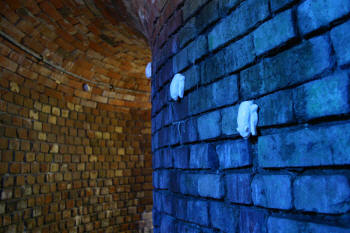|
|
| home | features | exhibitions | interviews | profiles | webprojects | gazetteer | links | archive | forum |
|
MINED Cornish Mines and Engines, Pool 28th - 6th July
How far should an artist go in making art that is sensitive to its setting? To what extent should they sacrifice their authorial presence, or artistic preoccupations, and in doing so is it better to respond to the site at an aesthetic or thematic level? The eight artists that contributed to MINED, at Cornish Mines and Engines, Pool in July 2008 offered a range of plausible answers to these questions. Visitors to the museum site are encouraged to follow a path through it that tells the story of mining in Cornwall. Steven Paige photograph's of the museum storerooms and hidden areas appeared to cut across the linear flow of these narratives, and gently expose their artifice. Called 'An examination into the workings of a Museum' (below left) they were placed discretely on the walls of the old compressor house: now ironically rebranded by the National Trust as the 'Discovery Centre'.
More assertively present in the same space
was the excellently titled 'This revolution is for display purposes
only' (above right), by Emma Churchill. Clunky and slightly kitsch, like a giant wheel
of fortune, it depicted a miner as Leonardo's Vitruvian man with arms
outstretched on a board that rotated at considerable speed. Not very
dignified for the miner: the work contained a Naumanesque hint of
violence or even sadism, and resisted trite or easy interpretations.
Another work which was similarly quirky, yet
gentler, was Alison Sharkey's 'Colonia' (below left) which
consisted of little white animals attached to the walls and ceiling of
a brick-lined subterranean corridor. Closer inspection revealed them to be
ceramic bats, their glaze glinting in a haunting blue light. In
their solidity and colour they echoed the form of the little
stalactites that they shared the space with, and like them were
oblivious to the human activity all around them.
Back outside, the remaining works were
inspired more by the history of the site. At the foot of the engine
house, were a series of little channels dug into the ground: called
'Scarred' (above right) by John Keys, the work attempted to
make visible the lodes of ore running beneath the ground. Analogous in
its form to a radiating network of mine-tunnels, it was appropriate
that one of the works in the show should have a digging process at its
heart.
Easily missed, 'Windows' (below left) by Jane Atkinson comprised 12 or more acrylic vitrines placed, like votive offerings, in recesses in a series of thick concrete walls. Each vitrine contained items such as candles, photographs, a length of chain and samples of ore, and the work thus became a makeshift outdoor museum. Compared to the bigger one inside, this diminutive display of artifacts seemed to offer a shift in emphasis away from story-telling towards a celebration of the magical/poetic qualities of the objects themselves.
Patrick Lowry's work 'Cage' (above right) nearby was also easily missed, but this time because it was predicated on a process of concealment: the artist engaging the viewer in a elaborate game of hide and seek using a sculpture that was carefully camouflaged within its surroundings. Made mainly in wood stained to simulate metal, it demonstrated a high level of loving craftmanship, but it operated on other levels as well. The fact that the object was half-sunk into the ground hinted at a story or narrative, in which the cage, as a device that was used to carry miners down into the mine, appeared as a menacing symbol of entrapment or control. It was these additional layers of metaphor that gave this highly site-specific sculpture its strength. Inside the hugely impressive main engine house (the house isn't very impressive but the engine inside most definitely is) were two works that drew strongly on memory and juxtaposed the recollections of ex-miners with the machinery that they once worked. 'From the chamber to the grave' by Amanda Lorens was a sound installation that blended music and spoken dialogue. An interview with a miner taken from the Cornwall audio/visual archive was mixed with live recordings of the Levant beam engine steaming. This was combined with a traditional poem more recently put to music (by composer Jim Carey) to produce a dense and multi-layered work.
'One by one' by Allessandra Ausenda, was situated on the top floor of the engine house. Pristine white triangles of cotton bearing B&W photographs of miners hands were draped over the rungs of an old wooden ladder. As they moved gently in the breeze, their delicacy and translucency contrasted poignantly with the heavy industrial machinery elsewhere on the site. Etherial and ghostly, the work seemed to speak of the elusiveness of memory and the transience of life.
RW 1/7/08
|
|
|

